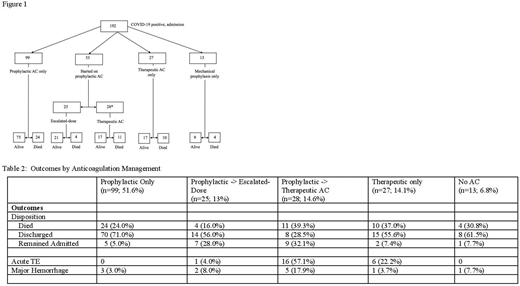Introduction: Early studies identified a prothrombotic state associated with novel coronavirus disease 2019 (COVID-19) as well as a survival benefit observed with heparin use in severely ill COVID-19 patients. There is a need to clarify the incidence of thromboembolic events (TEs), as well as major hemorrhage in COVID-19 patients in the context of an escalated-dose thromboprophylaxis strategy.
Methods: We conducted a single center, retrospective study of 192 consecutive patients with COVID-19 admitted to the hospital between March 26th and May 8th 2020. Our study aimed to investigate the rates of thromboembolic events (TEs), hemorrhage and mortality of in the context of an escalated-dose thromboprophylaxis strategy implemented early in our experience with hospitalized patients with COVID-19.
Results: The incidence of radiographically-confirmed venous thromboembolism (VTE) was 7.3% (n=14), and the rate of combined TEs was 12% (n=23). The rate of major hemorrhage was 6.3% (n=12), including one fatal CNS bleed. The overall mortality rate was 27.6% (n=53).
Conclusion: The rate of VTE and overall TE was much lower than was reported in early studies, and the majority of VTEs occurred in ambulatory patients. Our data suggest that an escalated-dose thromboprophylaxis strategy may help reduce the incidence of inpatient VTEs, and that ambulatory COVID-19 patients may benefit from primary thromboprophylaxis. However, the risk of bleeding was not negligible, and must therefore be assessed on an individual and continual basis when using a more aggressive thromboprophylaxis strategy.
No relevant conflicts of interest to declare.
Author notes
Asterisk with author names denotes non-ASH members.


This feature is available to Subscribers Only
Sign In or Create an Account Close Modal